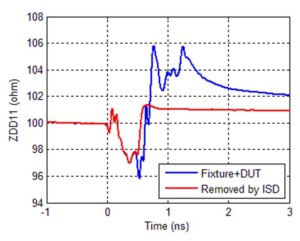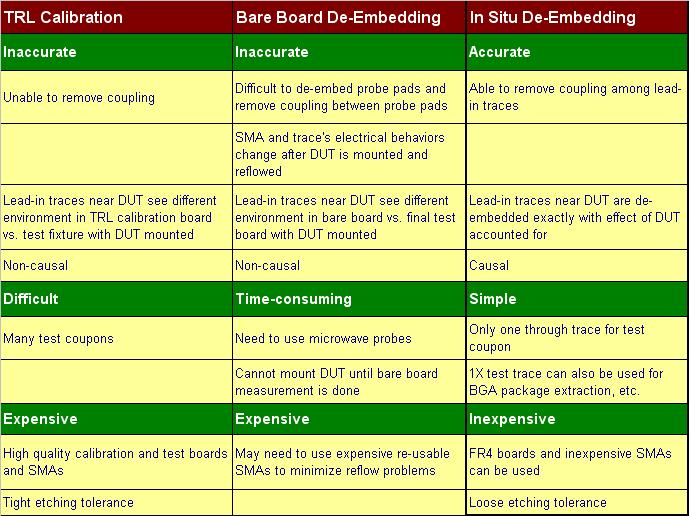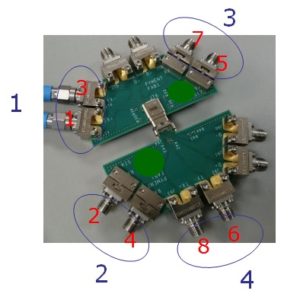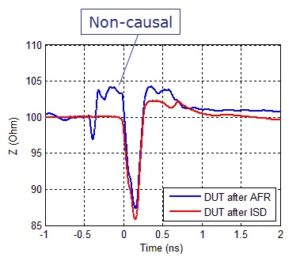The most accurate de-embedding tool
If you ever need to do TRL calibration, you will find AtaiTec’s patent-pending In Situ De-embedding (ISD) technique most useful. Compared to more than seven test coupons on a TRL calibration board, ISD needs only one through trace. TRL requires that the calibration board and DUT test fixture have identical characteristic impedance, which is an impossible feat to achieve. In addition, TRL does not remove coupling among lead-in traces. The result is that the S parameters of DUT after TRL calibration are almost always non-causal and are difficult to correlate with simulation. ISD addresses all of these issues with a very simple procedure: (a) measure the through trace test coupon (which only needs to have similar, but not identical, behavior as the DUT test fixture); (b) measure DUT + test fixture; and (c) run ISD software.
See Presentation for more details.
Example 1
In this example, the DUT is a mezzanine connector. A test fixture and 2x thru coupon were built:

The SMA and lead-in traces were de-embedded with the same exact differential impedance from DUT + test fixture in 4-port VNA measurement, as shown below in time-domain differential impedance profile.

The non-causal response after TRL, which is attributed to the impedance variation between TRL calibration board and actual DUT test fixture, is clearly seen in the following figure. ISD is free of causality error. Note the big difference in return loss, too.

Click HERE for more details and see how ISD can be more accurate, simpler to operate, and less expensive than TRL and bare board de-embedding:

ISD vs. AFR
See the ISD advantages: (Click here for a complete list.)
- Gives more accurate and causal results
- Impedance corrected 2x thru and 1x open/short
- Uses standard substrates, etching tolerances and connectors for the test fixture and coupons
- Saves hardware cost
- Extracts crosstalk from a single trace test coupon
- Extracts small DUT from a large board
- De-embeds asymmetric structures
- Support of unlimited number of ports for Fixture+DUT
- Able to de-embed odd number of ports
- Able to de-embed n ports out of m-port structures (n<m and n, m are arbitrary)
- 2x thru can be 2*m ports where m is arbitrary and 1x open/short can be 1 or 2 ports
- Scaling of delay and attenuation
- Able to de-embed longer or shorter than existing coupons
- Automatic skew calculation and de-skewing
- One click does it all
- Built-in Delta-L calculation
- One click compares ISD and Delta-L results
- Outputs trace (DUT) impedance
- Creates effective 2x thru from 1x open + 1x short ( - AtaiTec's patent)
- Built-in TDR and other SI functions
- Support of wildcard character (*) to de-embed multiple files in one setup
- Runs in batch to stack up multiple jobs
- Exceeds IEEE P370 requirements
Example 2
See the comparison between ISD and AFR in de-embedding a resonator structure:

Example 3
See additional comparison between ISD and AFR in de-embedding a USB Type-C connector:




Example 4
Click HERE to see how to use ISD to create probe models. The unique 1x open + 1x short and in-situ de-embedding methodology makes calibration to probe (or even pogo pin) tip possible.
GREAT ROI
Want to know how you can save SMAs, board material, and time in VNA measurements? Just try our In Situ De-Embedding (ISD).
FREE TRIAL
Just send us two Touchstone files — one for 2x through trace and one for DUT + test fixture — and we will send you the extracted DUT Touchstone file. To try out the software yourself, just send us your computer's MAC address and we will send you a temp license.
